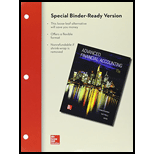
Concept explainers
a.
To compute: The number of shares issue to acquire Company C.
Introduction: Internal expansion refers to situation in a company forms a subsidiary by transferring some of its assets and liabilities and in exchange of ownership shares. Shares of the subsidiary is either provided to the shareholders in addition to their existing shares (Spin off) or in exchange of their existing shares (split off).
b.
To compute: The total market value of shares issued by Company E.
Introduction: Internal expansion refers to situation in a company forms a subsidiary by transferring some of its assets and liabilities and in exchange of ownership shares. Shares of the subsidiary is either provided to the shareholders in addition to their existing shares (Spin off) or in exchange of their existing shares (split off).
c.
To compute: The fair value of inventory at combination date holds by Company C.
Introduction: Internal expansion refers to situation in a company forms a subsidiary by transferring some of its assets and liabilities and in exchange of ownership shares. Shares of the subsidiary is either provided to the shareholders in addition to their existing shares (Spin off) or in exchange of their existing shares (split off).
d.
To compute: The fair value of identifiable net assets at combination date holds by Company C.
Introduction: Internal expansion refers to situation in a company forms a subsidiary by transferring some of its assets and liabilities and in exchange of ownership shares. Shares of the subsidiary is either provided to the shareholders in addition to their existing shares (Spin off) or in exchange of their existing shares (split off).
e.
To compute: The
Introduction: Internal expansion refers to situation in a company forms a subsidiary by transferring some of its assets and liabilities and in exchange of ownership shares. Shares of the subsidiary is either provided to the shareholders in addition to their existing shares (Spin off) or in exchange of their existing shares (split off).
f.
To compute: The balance in
Introduction: Internal expansion refers to situation in a company forms a subsidiary by transferring some of its assets and liabilities and in exchange of ownership shares. Shares of the subsidiary is either provided to the shareholders in addition to their existing shares (Spin off) or in exchange of their existing shares (split off).
g.
To compute: The amount of
Introduction: Internal expansion refers to situation in a company forms a subsidiary by transferring some of its assets and liabilities and in exchange of ownership shares. Shares of the subsidiary is either provided to the shareholders in addition to their existing shares (Spin off) or in exchange of their existing shares (split off).
Want to see the full answer?
Check out a sample textbook solution
Chapter 1 Solutions
LOOSE-LEAF Advanced Financial Accounting with Connect
 Cornerstones of Financial AccountingAccountingISBN:9781337690881Author:Jay Rich, Jeff JonesPublisher:Cengage Learning
Cornerstones of Financial AccountingAccountingISBN:9781337690881Author:Jay Rich, Jeff JonesPublisher:Cengage Learning




